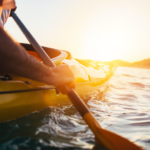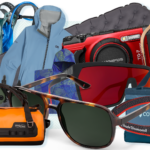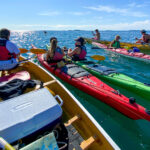by Chris Lennon
If you’ve already read Ski Canada’s Buyer’s Guide last issue, you will have noticed that reverse camber skis (their tips and tails don’t touch when the ski bases are put together) are being sold to the mainstream. Gone are the days when a rockered ski was something only a few athletes were taking with them on photo shoots to Alaska. Now, virtually every manufacturer has a pair of these boards in their lineups, and many offer two or three. Chopsticks, Hellbent, Kuro—whatever model you gravitate toward—if you like to play in the powder, do yourself a favour and get on a pair of these this winter. They’re a blast in anything soft, and most current models are quite manageable in all but the worst boilerplate. When you do demo a pair of these babies, remember that with underfoot widths in the 130-mm range, they are meant to float and slarf more than carve.
1. Don’t worry about being overly precise. 2. Let your skis skid a little. 3. The beauty of these skis is that you can float and slarf (a sloppy or skidded carve) your way down the hill without being strong on your edges.
Now we’re rockin’
by Martin Olson
Manufacturers have explored a number of shape innovations to try to make bigmountain skis manoeuvrable and versatile in the conditions above treeline that vary from bottomless powder to windblown slab. Reverse camber skis such as the Volant Spatula were the beginning, but now several brands offer skis with varying amounts of “rocker” as well as a combination of camber and sidecut in some models. Rocker describes how much of the ski is bent upwards when it’s on a flat surface. In other words, how far back does the tip start? The more rocker, the greater the float—700 mm is a lot of rocker; 200 is just enough to make a difference. Just to complicate things, K2 also measures how high the tip bends up, so its rocker measurement is two numbers.
To make a rockered ski a bit more versatile, various brands are experimenting with a small amount of camber underfoot and also a short midsection with sidecut for control on the groomed.
Until there’s a standard, forget the small picture. Big rocker for big snow. Some camber and sidecut for on-piste will make your life easier. Only the bravest of the brave would buy one of these without trying them.
Sticks and stones …
by Chris Lennon
One of the best places to get some fresh lines during the early part of the season is in the trees, away from the crowds and out of reach of the groomers. This sequence was shot last fall on Blackcomb, well before my parents in the east had put away their golf clubs for the year. Of course, the danger in pillaging these stashes while others are still working on their short game is that early-season snowpack is often thin. To get the most out of your first days on the hill, go exploring cautiously, perhaps on your roommate’s skis, and keep these pointers in mind: 1. Stay light on your feet so you can bounce over any fallen logs that get in your way. 2. Keep your tips up even if this means being balanced on your heels more than your toes. 3. Catching an unseen rock on the base of your skis isn’t the end of the world, but sinking your tips below a buried branch could spell and early end to your season. 4. Keep your skis pointed relatively downhill and avoid making big turns. 5. Keep your eyes open and look ahead to avoid obstacles. 6. Locate those deep pockets of snow to help control your speed and remind you why you’re thrilled that summer is a distant memory.



